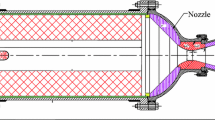Abstract
Arrangements and morphologies of Rockwool fibres have a great influence on the brake friction material microstructure, properties and performances. This study aims to establish the link between Rockwool fiber arrangement in the composite friction material and the friction and wear behavior. In order to limit synergistic effects, the adopted approach is based on efficient simplified formulations by the reduction of size distribution and number of constituents. Two different Rockwool fiber arrangements are selected. They are introduced as fiber balls for the first material and as separated fibers for the second one. Tribological behavior and wear mechanisms are investigated and correlated to microstructural properties of the studied materials. It is found that the induced microstructure has an impact on friction coefficient evolution and wear rate. Indeed, homogenous distribution of constituents in the material volume is achieved with the regular size and shape of fiber balls. These latter result in the clustering of conductive particles namely graphite and thus enhances thermal properties. Besides, regular size and uniform distribution of fiber balls contribute to a better supplying of third body in the contact and reduces wear rate. However, big porosities induced by fiber entanglements disrupt the develo** of third-body layer. Therefore, these porosities affect the stability of friction coefficient and generates a low wear resistance.
Access this chapter
Tax calculation will be finalised at checkout
Purchases are for personal use only
Similar content being viewed by others
References
Pavitra, J., Bharath, P.B., Suresha, B., Sasikumaran Nai, B.: Effect of short glass fiber and ferrosilicon content on mechanical properties of phenolic based friction composite material. Mater. Today Proc. 5, 7915–7923 (2018)
Cho, M.H., Kim, S.J., Kim, D., Jang, H.: Effects of ingredients on tribological characteristics of a brake lining: an experimental case study. Wear 258, 1682–1687 (2005)
Lei, H.F., Zhang, Z.Q., Liu, B.: Effect of fiber arrangement on mechanical properties of short fiber reinforced composites. Compos. Sci. Technol. 72, 506–514 (2012)
Scheider, I., Chen, Y., Hinz, A., Huber, N., Mosler, J.: Size effects in short fibre reinforced composites. Eng. Fract. Mech. 100, 17–27 (2013)
Kim, Y.C., Cho, M.H., Kim, S.J., Jang, H.: The effect of phenolic resin, potassium titanate, and CNSL on the tribological properties of brake friction materials. Wear 264, 204–210 (2008)
Ozturk, B., Ozturk, S.: Effects of resin type and fiber length on the mechanical and tribological properties of brake friction materials. Tribol. Lett. 42, 339–350 (2011)
Hentati, N., Kchaou, M., Cristol, A.L., Najjar, D., Elleuch, R.: Impact of post-curing duration on the mechanical, thermal and tribological behavior of an organic friction material. Mater. Des. 63, 699–709 (2014)
Makni, F., Kchaou, M., Cristol, A.-L., Elleuch, R., Desplanques, Y.: A new method of mixing quality assessment for friction material constituents toward better mechanical properties. Powder Metall. Met. Ceram. 56(1–2), 1–13 (2017). https://doi.org/10.1007/s11106-017-9864-x
Makni, F., Cristol, A.-L., Kchaou, M., Elleuch, R., Desplanques, Y.: Synergistic effects of fiber arrangements on the microstructure and properties of organic composite materials. J. Compos. Mater. 54, 4621–4634 (2020)
Guadagno, L., Vietri, U., Raimondo, M., Vertuccio, L., et al.: Correlation between electrical conductivity and manufacturing processes of nanofilled carbon fiber reinforced. Compos. B 80, 7–14 (2015)
Blau, P.J.: Microstructure and detachment mechanism of friction layers on the surface of brake shoes. J. Mater. Eng. Perform. 12, 56–60 (2003)
Shorowordi, K.M., Haseeb, A., Celis, J.P.: Velocity effects on the wear, friction and tribochemistry of aluminum MMC sliding against phenolic brake pad. Wear 256, 1177–1178 (2004)
Baklouti, M., Cristol, A.L., Desplanques, Y., Elleuch, R.: Impact of the glass fibers addition on tribological behavior and braking performances of organic matrix composites for brake lining. Wear 330–331, 507–514 (2015)
Acknowledgements
This work is part of thesis MOBIDOC funded by the European Union under the PASRI program. The authors thank the Ministry of Higher Education and Scientific Research in Tunisia, the Ministry of Foreign Affairs in France. The National Center for Scientific Research, and the Joint Committee of University Cooperation for their support for cooperation between the Laboratoire de Mecanique de Lille and the Laboratoire des Systemes Electro-Mecaniques at the University of Sfax. The authors gratefully acknowledge the International Campus on Safety and Intermodality in Transportation (CISIT), the Nord-Pas-de-Calais Region, the European Community, the Regional Delegation for Research and Technology, the Ministry of Higher Education and Research, and the National Centre for Scientific Research for their continued support of research on braking by friction at Laboratoire de Mecanique de Lille. Special thanks are also due to the STUGAFREM Society (Tunisia) for providing us with the brake lining samples. The authors also gratefully acknowledge the helpful comments and suggestions of the reviewers, which have improved the presentation.
Author information
Authors and Affiliations
Corresponding author
Editor information
Editors and Affiliations
Rights and permissions
Copyright information
© 2023 The Author(s), under exclusive license to Springer Nature Switzerland AG
About this paper
Cite this paper
Makni, F., Hentati, N., Cristol, AL., Desplanques, Y., Elleuch, R. (2023). Effects of Rockwool Fiber Arrangement on the Tribological Behaviour of Composite Brake Friction Materials. In: Walha, L., et al. Design and Modeling of Mechanical Systems - V. CMSM 2021. Lecture Notes in Mechanical Engineering. Springer, Cham. https://doi.org/10.1007/978-3-031-14615-2_98
Download citation
DOI: https://doi.org/10.1007/978-3-031-14615-2_98
Published:
Publisher Name: Springer, Cham
Print ISBN: 978-3-031-14614-5
Online ISBN: 978-3-031-14615-2
eBook Packages: EngineeringEngineering (R0)




